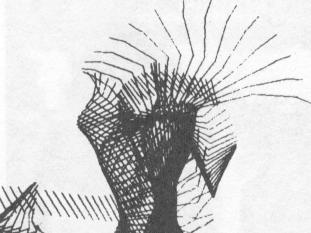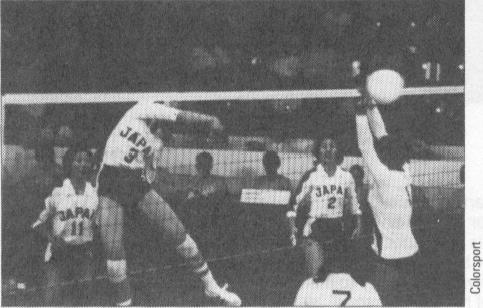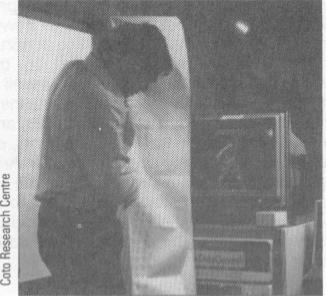| Previous | Index | Next |
![]()
display as well as its centre of gravity. When the performer is present this is reasonably easy. But if he is not there, Ariel derives the material from massive compilations made by NASA. Ariel uses the NASA tables to find the ratio of body segments to total body weight; of segment lengths to total height, as well as the body's specific gravity. He feeds the anatomical data into the computer, along with the joint centre positions.
Using his knowledge of the film speed and the displacement of the joint centres during the whole motion sequence, the analyst can calculate the velocities of body segments. From the velocities of the segments he can work out the acceleration at play and the computer can give him a segmental breakdown of information detailing the whole motion - including speeds; accelerations; horizontal, vertical and resultant forces; the amount of the muscle action in each joint and differences resulting from the discrepancies in body builds.
With computer-digitized biomechanics the analyst and trainer is given a fixed image of the relationship of every part of the body to every other part during the
Below Using computer programs that took over 10,000 hours to write, Dr Ariel was able to compare the performance of Flo Hyman of the US Olympic Volleyball team to that of Japan's best player. The stick figures on the screen can be rotated to any angle by using a joy stick to give a threedimensional quality.
whole movement sequence. Even tiny flaws will be shown up.
Ariel has programmed the computer to juggle with an electronic copy of an athlete. The anal~t can change the angles, the timing, even the weight of the image and compute how the performance would be affected by these changes. The athlete's initial performance is the raw material that can be honed into perfection on the screen. The lessons learnt can then be applied to the original performer.
To date, the application of computer biomechanics has been impressive. Al Oerton's case is riot alone in the field events that have been improved. Mac Wilkins, another gold medallist discus-thrower has been filmed in action. And the computerized image revealed that the impetus of his throw was greatly reduced as too much energy was channeled into his front leg. DrAriel explained that the best method for him would be to decelerate the heavy part of his anatomy - his trunk and legs - so that the lighter parts - the arms and the discus - would accelerate.
New light on bad habits
The computer analysis of Wilkins' performance revealed that he was actually about 30 per cent faster in his swing than fellow throwers who were also filmed. But he was dissipating the speed at the end of his turn. The computer projected that with a perfectly timed summation of forces, Wilkins would be able to throw the discus 76 m. And putting his knowledge of his potential into practice, Wilkins went on to win the Olympic Gold medal in the event with a throw of 70.9 m.
An analysis of shot putter Terry Albritton revealed a similar problem. Albritton was bending his front leg at the knee just as he was about to release the shot. 'It was like trying to throw from a trampoline or shoot a cannon from a canoe' said Ariel. One month after this analysis, Albritton became the next world-record holder - putting the shot 21.85 m.
Biomechanics has directly challenged some accepted theory and training methods. Long jumpers, for example, have always trained by rising to their toes under heavy weights, strengthening their calves for the final push from the kick board. But analysis has revealed that the best jumpers did not point their toes until the pushing foot is already two feet off the ground. The free leg was seen to be far more important than the pushing leg. The free leg and the torso accelerate as the planted leg decelerates. When the jumping leg is yanked off the ground it is no longer pushing but trying to catch up!
Ariel's study of long distance running - generally considered to depend upon the athlete's blood-pumping efficiency - revealed that biomechanical factors are vital. The running speed and the runner's work out-put depends on the stride length and frequency. Previous studies suggested that
SCIENCE NOW VOL. I, PART 5 1982
Right To discover
why Japanese volleyball teams were so unbeatable, blomechanical studies were made of their play. Using film speeds of up to 10,000 frames per second, Dr Ariel was able to analyze their play in
digital form (above). This analysis showed that the Japanese players timed their shots better and were faster.
American teams now lead the world.




![]()
| Previous | Index | Next |